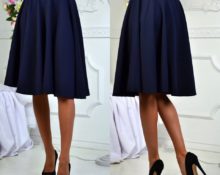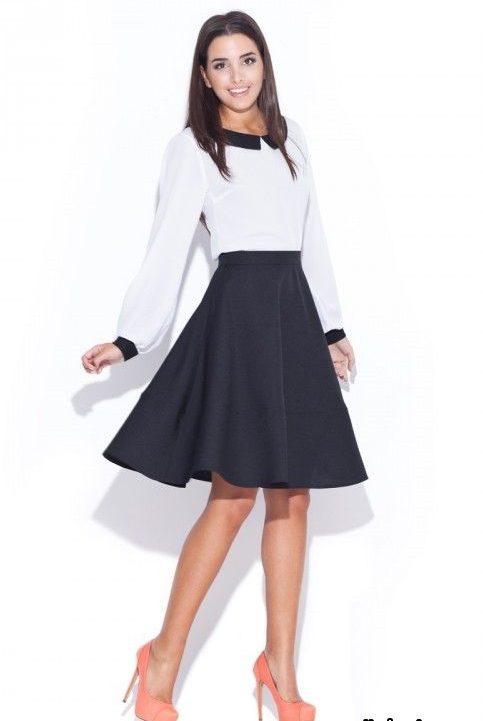 Skirts from the “Solar Family” have not gone out of fashion for a long time. They are quite easy to sew, even a novice seamstress can create their patterns., and they provide a lot of opportunities for modeling.
Skirts from the “Solar Family” have not gone out of fashion for a long time. They are quite easy to sew, even a novice seamstress can create their patterns., and they provide a lot of opportunities for modeling.
Cutting is not as difficult as it might seem, we suggest you build a pattern step by step and sew a flared skirt. The light cut will bring pleasure.
The simplest representative is the half-sun.
How to sew a half-sun skirt with your own hands?
Half-sun refers to skirts that require only one pattern for the front and back panels.
Types of skirts by number of seams:
- with one seam;
- with two seams.
Types of skirts based on top design:
- on the yoke;
- with elastic;
- on the belt.
 Types of skirts according to fabric features:
Types of skirts according to fabric features:
- with a smooth panel;
- with folds;
- with slits;
- with tucks.
By combining the parameters of these samples, you can create a completely unique model.
Fabric selection
In this style, the choice of fabric is more important than anywhere else, it depends on how your new thing will look.This look will be successful in any case, but the thin flying fabric will literally curl around your legs, dense fabric will fall in heavy tails.
 Most often used:
Most often used:
- twill;
- drape;
- viscose;
- artificial suede;
- dense polyester;
- linen, often dense, coarse;
- crepe georgette;
- taffeta;
- mesh;
- tulle in several layers;
- thick silk.
Construction of the main pattern
Let's look at step-by-step instructions on how to cut out a half-sun skirt for women or girls.
Important! All conical skirts have curvature coefficients for the upper waist circumference. Our task is to choose the type of skirt. For a half-sun skirt, this coefficient is 0.64.
 Required measurements:
Required measurements:
Waist circumference (the main measurement for this model) - measurements are taken at the narrowest point of the body. It is good to leave the cord or tape at the waist for later measuring the length of the product.
Hip circumference - measurements are taken along the protruding areas of the hips, buttocks, for this model you can capture the stomach.
The length of the skirt is from the waistline vertically down the side to the estimated required hemline.
 Thus, to calculate the radius of the inner circle, we must multiply the waist circumference by 0.64.
Thus, to calculate the radius of the inner circle, we must multiply the waist circumference by 0.64.
The second way to calculate this radius is to divide the waist circumference by Pi, that is, by 3.14.
 Progress:
Progress:
- On a large sheet of paper we build a right angle with vertex O in the upper left corner.
- We mark the bisector of this angle; it is convenient to simply mark the angle at 45 degrees.
- Along the angle lines we plot points T and T1, equal to R1.
R1 is the radius of the waist circumference.
- From this circle on the sides of the angle we mark the length of the skirt - H and H1, respectively.
- We draw a second circle, the radius of which R2 is equal to R1 + TH.
- Later we will shorten the skirt in the central part by 1.5-3 cm, after it sags.
- Cut it out.
Belt

The belt pattern is a rectangle, the required width and length equal to the waist circumference, plus 7-8 cm for the fastener.
Features of constructing patterns, cutting and sewing various half-sun skirts
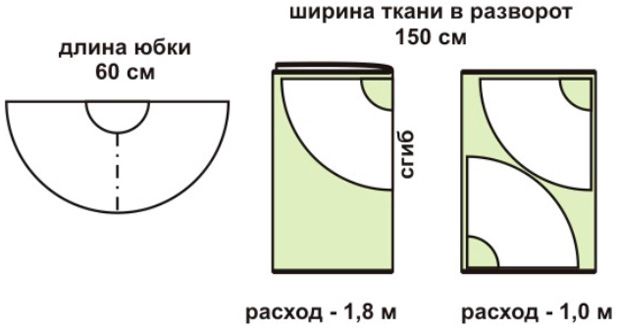
With one seam
This is the classic version:
- When cutting, we position the pattern so that the grain thread goes at an angle of 45 degrees to the center line of the skirt, then there will be beautiful tails.
- There is one seam on the side.
- Well suited for patterned fabrics.

Advice! For this, as well as other types of half-sun skirt, a hidden zipper is suitable.
With two seams
This style is chosen in case of saving fabric, also if the material has a small width - 80-110 cm.
 Two seams are located on the sides.
Two seams are located on the sides.
 The parts are usually arranged in a mirror order.
The parts are usually arranged in a mirror order.
Advice! If your fabric is quite narrow - 80-110 cm, it is convenient to place the pattern diagonally.
With elastic band
When creating a pattern for a skirt with an elastic band, the radius R will be calculated not using the volume or half-volume of the waist, but the hips:
- We substitute OB or PB into the formula you like, and calculate the volume of the small circle.
- Next, we build the pattern as usual.
- Open the standard one, but keep in mind that you will need to make a hem along the inner circumference and lay an elastic band.
With pleats
In this case, it is necessary to add folds when constructing the pattern.
Important! the location of the folds is determined strictly symmetrically relative to the left and right sides.
 The folds can be either one-sided or counter-fold.
The folds can be either one-sided or counter-fold.
Calculation of folds:
- We calculate the depth, as well as the number of folds.
- The amount of fabric per fold is 2 times greater than its depth.
- We calculate the radius of the waist circumference taking into account these folds.
 Example:
Example:
- You have 4 folds 3 cm deep.
- Waist circumference 74 cm.
R1 = (74+8Х3Х2)/3.14 =32.5
- We do all other calculations based on our R1.
- Don't forget to mark all the folds according to the picture.
 For waist circumference 69 cm and skirt length 80 cm. The pattern will look like this.
For waist circumference 69 cm and skirt length 80 cm. The pattern will look like this.
On the yoke

The half-sun on the yoke is a fairly common model., especially if you don’t want extra folds at the waistband.
There can be two types:
- Classic smooth cloth - with natural folds.
- With folds starting from the yoke.
 Construction always begins with the construction of a yoke. To do this, you need a skirt pattern - the base or a proven classic straight skirt that fits you well.
Construction always begins with the construction of a yoke. To do this, you need a skirt pattern - the base or a proven classic straight skirt that fits you well.
The fit of the yoke to the waist is achieved by closing the darts.
Advice! The yoke can pass either through the top of the dart, or above or below it, this is not important.
 Required measurements:
Required measurements:
- Waist circumference (the main measurement for this model) - measurements are taken at the narrowest point of the body. It is good to leave the cord or tape at the waist for later measuring the length of the product.
- Hip circumference - measurements are taken along the protruding areas of the hips, buttocks, for this model you can capture the stomach.
- The length of the skirt is from the waistline vertically down the side to the estimated required hemline.
- The circumference of the hips in the area of the yoke is carried out strictly along the line of the intended yoke.
- The height of the yoke is on the side from the waist line to the end of the yoke.
Important! We will build the half-sun based on the difference in the length of the skirt and the length of the yoke.
 Progress:
Progress:
- On a pattern - a base with one or two darts - mark the height of the yoke.
- If there is no base pattern, then you can build a yoke based on the fact that its width along the upper edge is equal to ¼ of the waist circumference + 2 cm.Along the bottom edge - if it runs along the hip line - the circumference of the hips + 1 cm for a loose fit, all divided by 4. See the picture.
- If the yoke goes above the hip line, then draw a pattern from the waist to the hips, and then draw the desired yoke line.
- We allocate the difference between the hip and waist measurements to the undercuts.
- Cut it out.
- We close the darts.
- We outline the new yoke pattern.
- Now for the radius of the waist circumference we take the number obtained from the basic formula you like, where instead of the waist circumference we take the circumference of the yoke.
- Mark the length of the skirt excluding the yoke.
- We build a pattern, choosing a smooth style or with folds.
General rules and sewing procedure:
- If the model is on a yoke, then sew the side seam of the yoke. Leaving an area for fastening.
- Sew the side seam(s), leaving an area for the fastener.
- If the product is on a belt, then we grind the belt cleanly.
- Sew the yoke or belt to the skirt panel.
- We sew in a zipper.
- Let the skirt hang on the hangers.
- We process the hem.
- Let's try it on.
Calculation of fabric for a semi-sun skirt
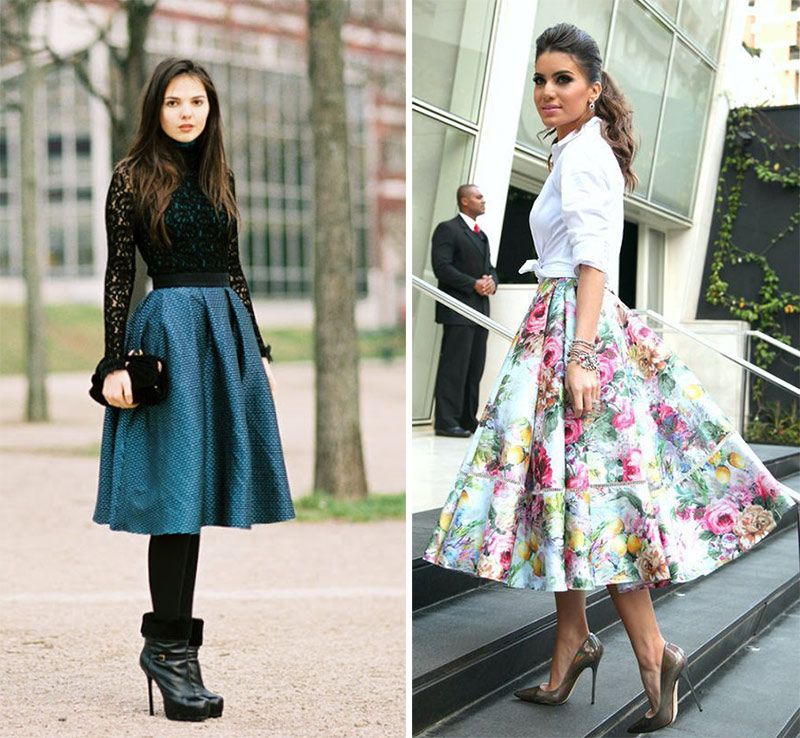
The amount of plain-dyed fabric is easier to calculate than for material with a pattern.
A complex, large-area geometric or floral pattern that requires matching rapport can double the consumption.
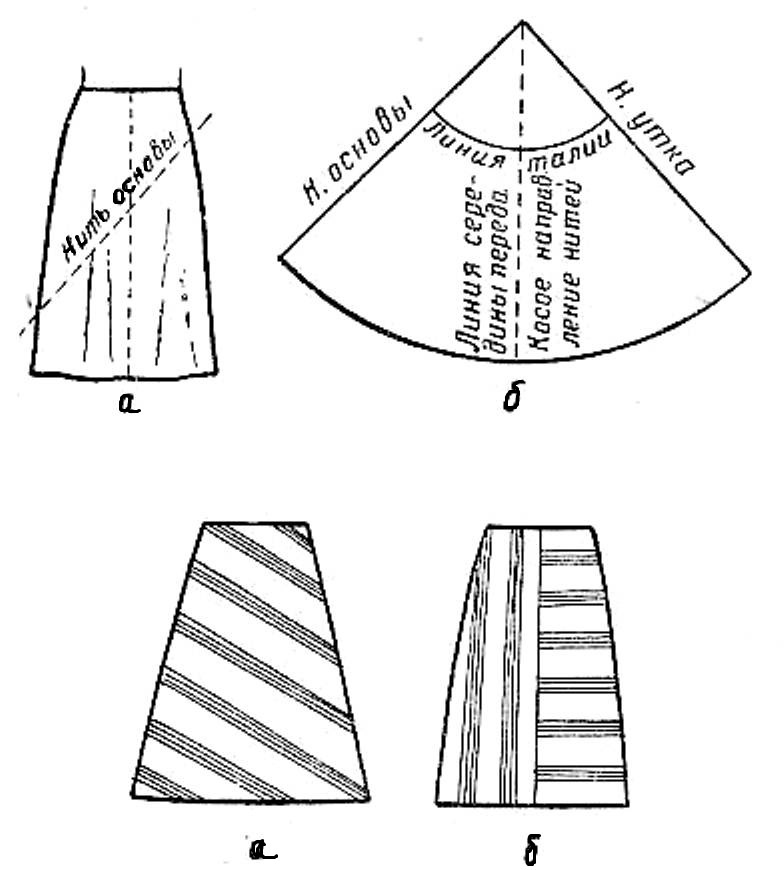 We can calculate the flow rate using the following formula:
We can calculate the flow rate using the following formula:
2X(R + D) + 10 cm.
- R – radius of a small circle, approximately equal to one third of the waist circumference, plus 2 cm for allowances.
- D – product length.
 This calculation is the main one, but not the only one.
This calculation is the main one, but not the only one.
The main thing is that regardless of the length of your skirt, this formula for finding the amount of fabric will work perfectly.

Skirt sun
It has always been believed that a half-sun skirt is suitable only for young, slender girls. This is fundamentally wrong.
Important! Properly selected fabric and stylistic features of this skirt will help not only hide flaws, but also highlight the advantages of any figure of a lady of any age.


 Advice! If your fabric is quite narrow - 80-110 cm, it is convenient to place the pattern diagonally.
Advice! If your fabric is quite narrow - 80-110 cm, it is convenient to place the pattern diagonally. Important! the location of the folds is determined strictly symmetrically relative to the left and right sides.
Important! the location of the folds is determined strictly symmetrically relative to the left and right sides. 0
0

